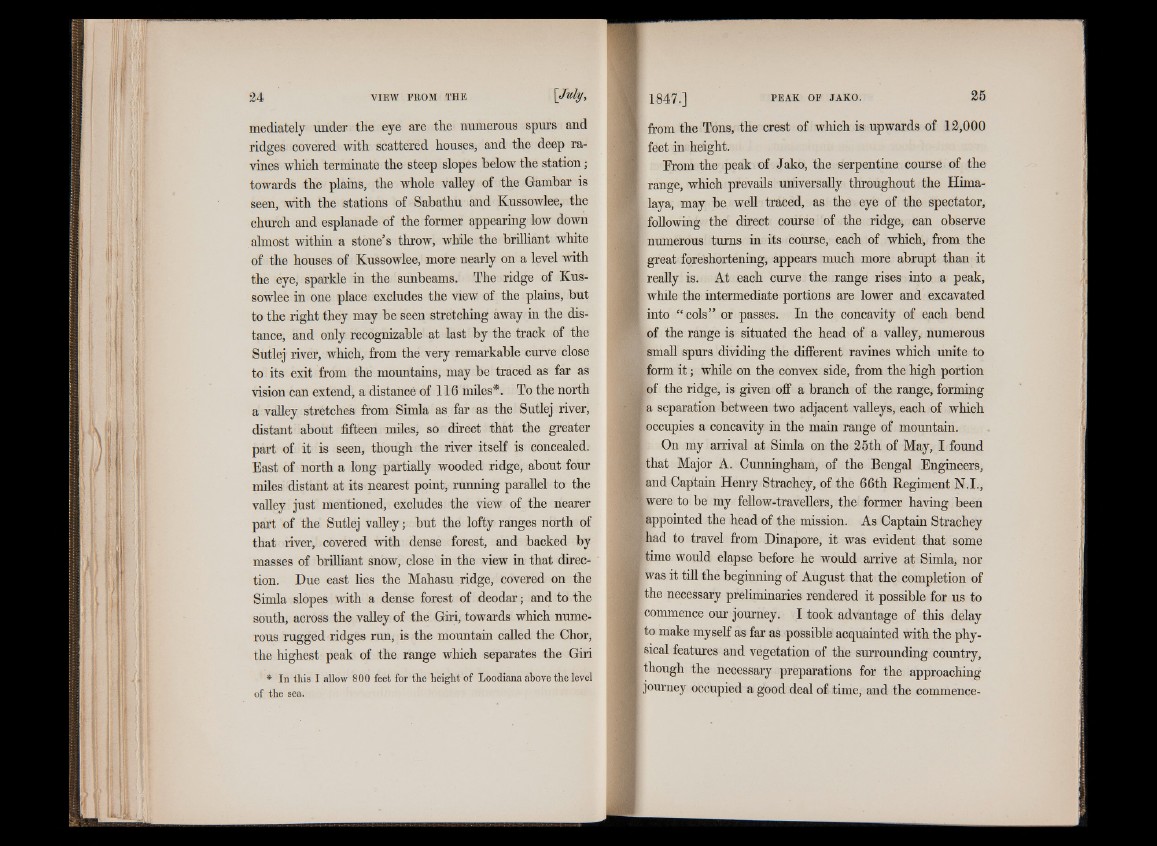
mediately under the eye are the numerous spurs and
ridges covered with scattered houses, and the deep ravines
which terminate the steep slopes below the station;
towards the plains, the whole valley of the Gambar is
seen, with the stations of Sabathu and Kussowlee, the
church and esplanade of the former appearing low down
almost within a stone’s throw, while the brilliant white
of the houses of Kussowlee, more nearly on a level with
the eye, sparkle in the sunbeams. The ridge of Kussowlee
in one place excludes the view of the plains, but
to the right they may be seen stretching away in the distance,
and only recognizable at last by the track of the
Sutlej river, which, from the very remarkable curve close
to its exit from the mountains, may be traced as far as
vision can extend, a distance of 116 miles*. To the north
a valley stretches from Simla as far as the Sutlej river,
distant about fifteen miles, so direct that the greater
part of it is seen, though the river itself is concealed.
East of north a long partially wooded ridge, about four
miles distant at its nearest point, running parallel to the
valley just mentioned, excludes the view of the nearer
part of the Sutlej valley; but the lofty ranges north of
that river, covered with dense forest, and backed by
masses of brilliant snow, close in the view in that direction.
Due east lies the Mahasu ridge, covered on the
Simla slopes with a dense forest of deodar; and to the
south, across the valley of the Giri, towards which numerous
rugged ridges ran, is the mountain called the Chor,
the highest peak of the range which separates the Giri
* In this I allow 800 feet for the height of Loodiana above the level
of the sea.
[ from the Tons, the crest of which is upwards of 12,000
I feet in height.
Erom the peak of Jako, the serpentine course of the
I range, which prevails universally throughout the Hima-
| laya, may be well traced, as the eye of the spectator,
I following the direct course of the ridge, can observe
I numerous turns in its course, each of which, from the
I great foreshortening, appears much more abrupt than it
I really is. At each curve the range rises into a peak,
I while the intermediate portions are lower and excavated
I into “ cols” or passes. In the concavity of each bend
I of the range is situated the head of a valley, numerous
Jt small spurs dividing the different ravines which unite to
|| form i t ; while on the convex side, from the high portion
■of the ridge, is given off a branch of the range, forming
Ba separation between two adjacent valleys, each of which
I occupies a concavity in the main range of mountain.
On my arrival at Simla on the 25th of May, I found
■ that Major A. Cunningham, of the Bengal Engineers,
B and Captain Henry Strachey, of the 66th Regiment N.I.,
■ were to be my fellow-travellers, the former having been
H appointed the head of the mission. As Captain Strachey
■had to travel from Dinapore, it was evident that some
■time would elapse before he would arrive at Simla, nor
I was it till the beginning of August that the completion of
I the necessary preliminaries rendered it possible for us to
■ commence our journey. I took advantage of this delay
1 to make myself as far as possible acquainted with the phy-
■ sical features and vegetation of the surrounding country,
I though the necessary preparations for the approaching
■ journey occupied a good deal of time, and the commence